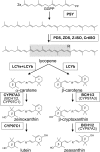Carotene Hydroxylase Activity Determines the Levels of Both α-Carotene and Total Carotenoids in Orange Carrots
- PMID: 24858934
- PMCID: PMC4079379
- DOI: 10.1105/tpc.113.122127
Carotene Hydroxylase Activity Determines the Levels of Both α-Carotene and Total Carotenoids in Orange Carrots
Abstract
The typically intense carotenoid accumulation in cultivated orange-rooted carrots (Daucus carota) is determined by a high protein abundance of the rate-limiting enzyme for carotenoid biosynthesis, phytoene synthase (PSY), as compared with white-rooted cultivars. However, in contrast to other carotenoid accumulating systems, orange carrots are characterized by unusually high levels of α-carotene in addition to β-carotene. We found similarly increased α-carotene levels in leaves of orange carrots compared with white-rooted cultivars. This has also been observed in the Arabidopsis thaliana lut5 mutant carrying a defective carotene hydroxylase CYP97A3 gene. In fact, overexpression of CYP97A3 in orange carrots restored leaf carotenoid patterns almost to those found in white-rooted cultivars and strongly reduced α-carotene levels in the roots. Unexpectedly, this was accompanied by a 30 to 50% reduction in total root carotenoids and correlated with reduced PSY protein levels while PSY expression was unchanged. This suggests a negative feedback emerging from carotenoid metabolites determining PSY protein levels and, thus, total carotenoid flux. Furthermore, we identified a deficient CYP97A3 allele containing a frame-shift insertion in orange carrots. Association mapping analysis using a large carrot population revealed a significant association of this polymorphism with both α-carotene content and the α-/β-carotene ratio and explained a large proportion of the observed variation in carrots.
© 2014 American Society of Plant Biologists. All rights reserved.
Figures





References
-
- Abramoff M.D., Magelhaes P.J., Ram S.J. (2004). Image Processing with ImageJ. Biophotonics International 11: 36–42
-
- Alder A., Jamil M., Marzorati M., Bruno M., Vermathen M., Bigler P., Ghisla S., Bouwmeester H., Beyer P., Al-Babili S. (2012). The path from β-carotene to carlactone, a strigolactone-like plant hormone. Science 335: 1348–1351 - PubMed
-
- Arango J., Salazar B., Welsch R., Sarmiento F., Beyer P., Al-Babili S. (2010). Putative storage root specific promoters from cassava and yam: cloning and evaluation in transgenic carrots as a model system. Plant Cell Rep. 29: 651–659 - PubMed
-
- Arscott S.A., Tanumihardjo S.A. (2010). Carrots of many colors provide basic nutrition and bioavailable phytochemicals acting as a functional food. Compr. Rev. Food Sci. Food Saf. 9: 223–239
-
- Auldridge M.E., Block A., Vogel J.T., Dabney-Smith C., Mila I., Bouzayen M., Magallanes-Lundback M., DellaPenna D., McCarty D.R., Klee H.J. (2006). Characterization of three members of the Arabidopsis carotenoid cleavage dioxygenase family demonstrates the divergent roles of this multifunctional enzyme family. Plant J. 45: 982–993 - PubMed
LinkOut - more resources
Full Text Sources
Other Literature Sources
Research Materials

